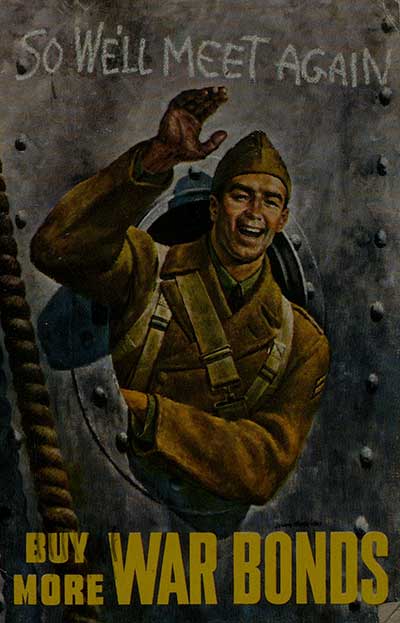Nature and Scope
Overview
Comprising extensive collections sourced from The National WWII Museum, New Orleans, this digital resource shows how World War Two changed American society and the economy, how it impacted individuals and their families, and the legacy of the war in human terms. From enlistment and training to deployment on the US Home Front or on campaigns overseas, the personal stories of these men and women demonstrate the broad spectrum of American involvement in the conflict.
American military and civilian participation in all major theaters of operations is represented, whilst service branches range from the army, navy and air force, to the marines, merchant marines, coast guard, women’s forces and medical personnel. Personal letters, diaries, photographs, artifacts and military records offer insight into operations in the Pacific, the D-Day landings in Europe and the post-war occupation of Germany.
Alongside the archival collections and artifacts, the oral history video interviews conducted by The National WWII Museum provide opportunities to learn about the personal experiences of veterans in their own words. They offer an invaluable insight into the involvement of American men and women in World War Two, both in a military capacity and as civilians on the Home Front, as well giving a voice to individuals who emigrated to the United States as a result of the war.
Key topics
- Front line experiences, including key campaigns around the world
- Key events such as Pearl Harbor, VE and VJ Day
- Naval warfare and amphibious operations and craft
- Women in the forces
- Medical services and army health
- Civilian life and the Home Front
- Air warfare and strategic bombing
- Enlistment and the draft
- Military training
Key archival collections
- Declassified top secret documents relating to the D-Day landing on Omaha beach, including the Neptune Monograph book prepared by the Commander Task Force 122
- Personal correspondence of Raymond Jordan Towle, 3rd Military Government Regiment, who was among the first American soldiers to enter Berlin in 1945
- Illustrated diary of an American prisoner of war in Stalag Luft III
- Documents collected by a pilot with the 362nd Fighter Group, "Mogin’s Maulers" of the 9th Air Force, who pioneered the fighter-bomber’s new role of dam busting
- Blueprints and organizational documents relating to employees of Higgins Industries, New Orleans, and the development of the Higgins landing craft
- Personal and military documents relating to Mary T. Lynes, the first woman in the Pacific to receive the Soldier’s Medal for heroism
- Photographs relating to the service of a surgeon with the 45th Portable Surgical Hospital, which moved between India, Burma and China
- Substantial correspondence of the Beene family; five brothers serving in different service branches, and three sisters on the US Home Front
- Items from the service of Major Birdie B. Daigle, who served with the United States Army Nurse Corps in the Pacific
- Uniforms, souvenirs and personal equipment, including a US M-1 infantry helmet worn by Edward Sabo, member of Easy Company, 101st Airborne Division during the Normandy invasion, many of which are viewable in 360 degree rotation
- Documents and photographs relating to the detonation of the atomic bomb
- Military decorations and insignia, including the Purple Heart and Medal of Honor
- Documents relating to individuals involved in the construction of the Ledo Road, a vital supply link for the Western Allies between India and China
- Extensive letter collections belonging to women who corresponded with multiple servicemen, including Bernice Bohlmann, a high school teacher who kept in touch with many of her former students once they entered the armed forces, and Connie Logsdon, an American teenager who corresponded with a large number of USAAF cadets and pilots, one of whom she eventually married
- Scrapbooks featuring the "Four Hollywood Blondes", an American roller-skating troupe with the United Service Organizations (USO), whose European tour coincided with the outbreak of war
Oral histories
The interviews demonstrate a wide range of experiences, including:
- A veteran of the famous 506th Parachute Infantry Regiment, 101st Airborne Division
- Members of women’s service branches, such as the Women’s Air Force Service Pilots (WASPs) and Women’s Army Corps (WAC)
- African American service personnel, including Tuskegee Airmen, nurses and marines
- Survivors of concentration camps, the Bataan Death March and prisoners of war
- Cryptography officers, including a Navajo code talker
- American civilians interned in the United States and in the Philippines
Read more about The National WWII Museum’s Oral History Program here.
Secondary features providing further tools for teaching and research:
- Explore the Browse Collections feature to learn more about the personal stories of the men and women whose archival collections and oral histories feature in this resource.
- Discover visual responses to the war in the Art Exhibition, which showcases sketches, cartoons, plane nose art and paintings produced by American service personnel.
- Use the Interactive Chronology to learn more about events relating to the American war effort and key campaigns, as well as the wider context surrounding their involvement.
- Read contextual Essays written by academic experts on a range of key themes.
Language and terminology
All editorial decisions relating to this project have been made with great care, consideration and with the utmost sensitivity.
Every care and attention has been paid to preserve the historic authenticity of these documents. Any terminology that may be deemed discriminatory or offensive by present-day principles may have been preserved for the historic accuracy and relevance to that particular document.


